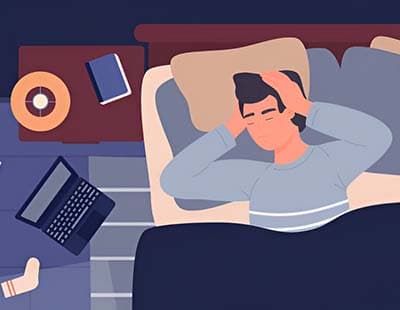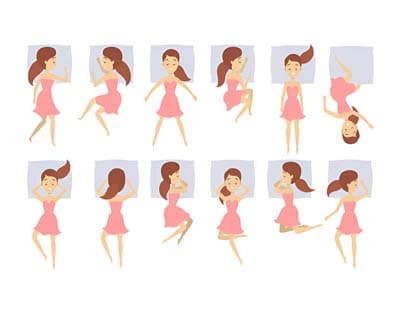Do you find that simply sleeping through the night isn't giving you that absolutely recharged feeling? It turns out you're not alone. With our increasingly fast-paced society, more of us are trying different ways to sleep to increase focus, mood, and energy.
Most interestingly, research suggests that splitting sleep into two bouts has been associated with greater quality of rest and better daytime performance. This was historically common before the advent of artificial light.
The Sleep Foundation states that almost one-third of adults experience insomnia and/or disturbance in sleep. Researchers are now finding that purposely splitting rest into shorter, intended sleep times could help re-synchronize the body’s natural circadian rhythms, improve memory consolidation and retention, and even increase levels of alertness.
There are, in fact, some small studies that demonstrate participants have more cognitive recovery, upwards of 20% after segmented rest than sleep continuously.
What is Biphasic Sleep?
Biphasic sleep describes a pattern in which a sleeper has two distinct sleep episodes within 24 hours, rather than one long sleep episode. Rather than a "monophasic" sleep pattern — in which a sleeper will sleep one time per night for 7–9 hours — biphasic sleep involves two separate sleep episodes, often consisting of a longer core sleep episode followed by a shorter nap or second sleep episode.
There really are two main types of biphasic sleep patterns:
1. First and Second Sleep Pattern (Traditional Biphasic Sleep): The traditional form of sleep pattern, wherein an individual sleeps for 3–4 hours, awakens for an hour or two to do things like read, pray, or reflect on life, and then returns to sleep for another few hours. This format was common in pre-industrial societies and may reflect the closest approximation of ancient human circadian rhythms.
2. Siesta Pattern (Modern Biphasic Sleep): This method is common in Mediterranean and Latin cultures and centers on a long, overnight sleep (typically 5–6 hours) and one daytime nap (60-90 minutes) to combat the natural energy dip following lunch, improving alertness and performance throughout the rest of the day.
Research has indicated that biphasic sleep may yield significant benefits — improved concentration, creativity, and memory; decreased fatigue; and reduced perception of stress. It may be a better way for individuals with flexible schedules to have their sleep aligned more naturally with the energy cycles their bodies experience.
To summarize, biphasic sleep is not about sleeping less — it is about sleeping better, and sleeping in a way that more efficiently supports recovery and cognitive function in the daytime.
Biphasic Sleep vs. Monophasic Sleep
The majority of the population today engages in a monophasic sleep style, defined by sleeping once a day, usually for 7 to 9 hours continuously overnight. This style emerged as the norm after the Industrial Revolution, when consistent work schedules and electric lights changed human habits.
Biphasic sleep entails sleeping twice a day, or rather dividing sleep time into two sleep periods in 24 hours, most commonly sleeping at night to daytime or napping, or some variation of night sleeping with “first” and “second” sleep periods.
Monophasic sleep has the obvious benefit of ease and consistency of routine, but it does not fit everyone's natural biological rhythm/minimal alertness requires more time in bed.
Most people experience a natural decrease in alertness and sleepiness during the afternoons, which is easier to accommodate when sleeping biphasically. In as little as a short nap or second sleep period, the wake-up nap and more mental clarity, productivity, and energy balance would be experienced.
For biphasic sleep to work, it also needs to be consistent and structured. If you don’t have a schedule, it will decrease sleep quality rather than improve it.
In the end, each sleep pattern has its advantages: monophasic sleep has the benefit of practicality for normal work schedules, and biphasic sleep may align better with your body’s natural energy cycles and be more restorative—allowing for some flexibility and/or work-life balance.
Biphasic Sleep vs. Polyphasic Sleep
While biphasic and polyphasic sleep both involve splitting sleep into multiple segments, they differ in structure, frequency, and purpose. Biphasic sleep divides the sleep cycle into two segments within a given 24-hour day, typically comprising a longer main nightly sleep period and a shorter nap or second sleep period.
Biphasic sleep is a moderate and natural form that is easy to practice, and it does not disrupt the rhythm of life, and has any negative consequences for health. In contrast, polyphasic sleep involves sleeping three or more times each day.
Some people use this method to maximize their time awake, including shift workers, military personnel, and others who are eager to increase productivity. The Everyman and Uberman sleep schedules are popular, utilizing short naps spaced throughout the day and night, while significantly decreasing total sleep time.
While polyphasic sleep may increase the number of waking hours available in the short term, studies have indicated that it may disrupt deep sleep cycles and long-term cognitive functioning if done for extended periods of time.
Conversely, biphasic sleep often better supports natural circadian rhythms, providing restorative sleep and mental clarity without a potentially significant reduction in overall sleep duration.

Benefits of Biphasic Sleep
There are multiple benefits to implementing a biphasic sleep schedule, both for the body and for the mind. This method of sleeping in two blocks better supports your natural circadian rhythm, leading to improved health and general well-being. Here are some benefits:
1. Decreased Daytime Fatigue and Better Mental Clarity
By splitting sleep into two segments, the midday slump that many people experience can be reduced. A battery charge at your pre-determined wake time can help the brain recharge its batteries, resulting in improved focus, decision-making, and reaction time throughout the day.
2. Better Memory and Learning
Research reveals that short naps can help with memory consolidation and learning. The second sleep or nap will give the brain more time to process the information, resulting in better memory and creativity with that information.
3. Improved Mood Management
Getting enough rest in multiple bouts supports mood stability and can decrease irritability. Restoring energy over shorter cycles may help reduce the cumulative effects of fatigue and stress associated with low-quality or inadequate sleep at night.
4. Accommodating for Modern Day Lifestyle
Biphasic sleep is advantageous for people who have irregular schedules, such as students, freelancers, or shift workers, who take advantage of natural energy lows to rest and recover. This allows individuals to meet their overall sleep needs at a convenient time, instead of planning around sleep during busy periods.
5. Possibility of Greater Sleep Efficiency
Some individuals may notice that they fall asleep quickly or get into deep stages of sleep more rapidly with segmented naps, leading their overall time in sleep to become more efficient and restorative, even with slightly less total sleep time.
6. Alignment with Natural Cycles
Human beings naturally have two periods of sleepiness, which are late at night and mid-afternoon. Biphasic sleep takes advantage of these natural biological circadian rhythms, allowing for a more natural and restorative sleep cycle.
Tips for Starting Biphasic Sleep
Adopting a biphasic sleep pattern will require time to adapt; however, once you regularly adhere to this sleep model with enough planning, it will feel natural and functional. The following tips can assist you in adopting this sleeping pattern.
1. Select Your Choice
Choose if you want to try the segmented pattern (two sleep periods at night with an intervening wake period) or the siesta pattern (long core sleep at night with a nap during the day). Pick according to your lifestyle and conviction.
2. Keep a Regular Schedule
Try to stay within the same sleep and wake times every day (weekends included). Regularity in timekeeping will help your biological clock to conform to this new natural cycle and allow both sleep sessions to be restorative.
3. Limit Naps to Be Short and Timely
If you're going the siesta route, in the early afternoon, try to keep naps to 60–90 minutes. Sleeping too late in the day and/or for too long can be disruptive to nighttime sleep.
4. Have a Sleep Environment Dedicated to Relaxation
Try to keep your bedroom dark, cool, and quiet. Use blackout curtains or an eye mask solution when it's dark, and try to find a relaxing surface during your nap to help get your body slipping into sleep.
5. Caffeine and Screen Avoidance Before Rest
Try to limit caffeine intake for several hours before each sleep, preferably even earlier, and try to limit bright screens that can suppress melatonin. Instead, try activities like before sleep, reading, light stretching, or meditating.
6. Pay Attention to Your Body
Your body can take about a week or two to adjust to a biphasic rhythm. If you feel excessively sleepy or groggy, play around with your nap length or timing until you find a schedule appropriate for you.
7. Focus on Total Sleep Time
Make sure you still sleep 7 to 9 hours of sleep in 24 hours. Biphasic sleep isn't waking up early or sleeping less; it is actively distributing your sleep in a way that boosts alertness and energy.
8. Follow Good Sleep Hygiene
Keep a consistent sleep schedule. Avoid caffeine, heavy meals, and screens right before bed. Make your sleeping space dark, cool, and quiet for optimal deep sleep. Spend some time relaxing with calming activities, like reading or meditating, before bed. Following good sleep hygiene will ensure that you get restful and effective sleep every biphasic sleep practice.
Final Thoughts
Biphasic sleep can be easy and beneficial for rest, focus, and energy by syncing your sleep with your body's natural rhythm. One of the advantages is that it offers flexibility for people who have busy calendars or irregular schedules. With consistency, good sleep hygiene, and sufficient total rest, this two-phase sleep pattern can help you sleep smarter and feel more refreshed throughout the day.






















